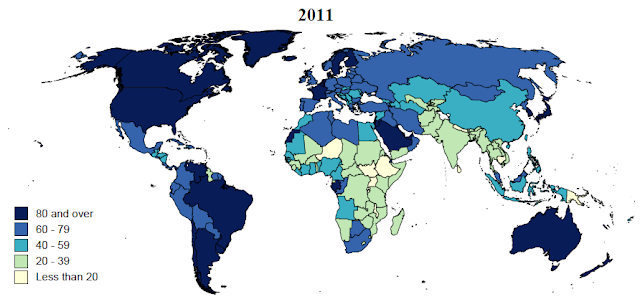The global proportion of urban population rose dramatically from 29% in 1950, to 49% in 2005. It is projected to rise to 60% (4.9 billion) by 2030.
Its in the middle of 2009, when the number of people living in urban areas (3.42 billion) had surpassed the number living in rural areas (3.41 billion).
However, there is a glaring disparity in urbanisation levels throughout the world as shown below.
However, there is a glaring disparity in urbanisation levels throughout the world as shown below.
Broadly, developed countires have more urbanisation levels than the developing and least developed countries. Urbanisation tends to increase with economic development and urban areas become major economic centres. For instance, the Mumbai megacity contributes 5% of India's GDP and its GDP is expected to grow five folds in next 20 years.
Urbanisation megatrend imposes challenges in both urban and rural settings.
Urban
As urban centres expands, the stress on civic infrastructure would increase, be it water, sewage, electricity or roads. Infrastructure of several sities are already stretched. City authories are banking on a combination of sensor network and information technologies to deliver 'Smart City' to cope with the demands.
Mobility, a key to vibrant and functioning city, is also being relooked with emphasis on multi-modal integration and sustainable transport strategies.
In addition to reactive approaches, proactive approach in terms of urban planning is also gaining importance. Urban planners and city agencies are getting together to plan controlled and sustainable expansion of cities. In recent times, city suburbs are far better planned than before. For instance, urban planners go for polycentric development with a theme for each centre. And for each centre, urban planners may go for mixed use (co-locating resdential and employment centres). Urban planning for each city is customised and there is no universal formula yet.
As urban areas become economic centres, more and more efforts will be invested in preserving their capacity of economic growth.
Rural
Rural may sound the poor cousin of urban in all the talk about urbanisation. However, ignoring rural would be a costly mistake. Rural economies will continue to serve our basic neccessities of food and clothing. Urban migration is aready posing a serious challenge to rural economies. One cannot stop migration, but one must ensure that rural areas continue to grow in spite of migration. Capacity building, technology driven practices and right produce are some of the intervention areas. For instance, the focus in developing countries like India would be more on mechanisation and improved agricultural practices to improve productivity. In addition, to improve revenue capability, the focus would be more on cash crops (including bio-fuel crops) and output quality (which could be bought by food processors at high prices).
Fate of both urban and rural economies are interconnected by demand and supply. If one goes down, it will drag down the another. Urbanisation is affecting both. Care must be taken that we do not pre-occupy ourselves with Urban issues that we lose sight of rural challenges.


No comments:
Post a Comment